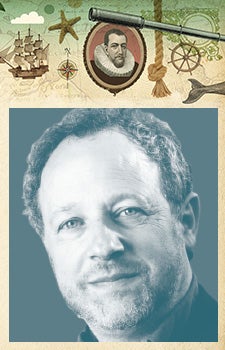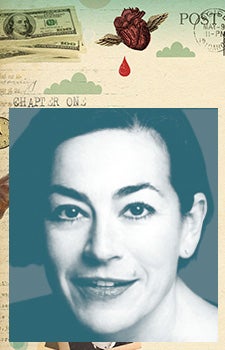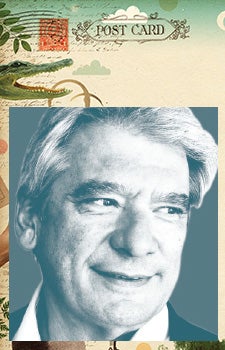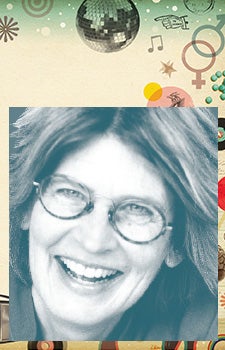Postcards From Memory Lane
Jerry Siegel came of age during the 1910s and ’20s. The youngest child of Jewish Lithuanian immigrants, Siegel often felt out of place in the blue collar, Midwestern atmosphere of his Cleveland, Ohio, neighborhood. When his father died of a heart attack during a robbery at his haberdashery, the shy and socially awkward teenager retreated further into his shell.
As he matured and found himself as an artist and storyteller, Siegel channeled his memories of growing up vulnerable and isolated in the big city — a metropolis, if you will — and used them to create one of the most iconic and enduring characters of the 20th century.
As Superman speeds toward his 75th birthday, Siegel’s thematic use of an immigrant outsider trying to fit into American culture continues to resonate with readers. It is this use of Siegel’s own memories of his early life in Cleveland that makes the superhuman so — humane.
Siegel’s approach to writing the legend of Superman also exemplifies one of the cardinal rules of good writing: “Write what you know.”
The best writers often take personal experiences and memories (either their own or those of others) and infuse their work with feelings, fears, sounds, tastes and other personal markers that give authenticity to their work. Utilizing memories to flesh out a story — whether an autobiography or a work of science fiction — lends the plotline a sense of gravitas and urgency.
I recently asked a quintet of accomplished USC Dornsife authors — novelists, historians, screenwriters, memoirists and poets — to contemplate the role that memory has in their writing. The degree to which all five rely on memories to inform their work may surprise you.

Peter Mancall is Andrew W. Mellon Professor of the Humanities and a professor of history and anthropology.
PETER C. MANCALL is Andrew W. Mellon Professor of the Humanities and a professor of history and anthropology. He is also the director of the USC-Huntington Early Modern Studies Institute and vice dean for the humanities in USC Dornsife. He has authored several books, including Fatal Journey: The Final Expedition of Henry Hudson (Basic Books, 2009) and Hakluyt’s Promise: An Elizabethan’s Obsession for an English America (Yale, 2007).
DK: From the cave paintings in France, to parchment scrolls, to bound diaries and even blogs, people have recorded their everyday occurrences for millennia. Where do you think the fascination with detailing personal events comes?
PM: I always try to be attentive to the places where individuals lived. For my study of the Elizabethan colonial promoter Richard Hakluyt, I needed to describe Oxford, London and Paris, where he spent the most important years of his life. In those places, he became obsessed with recording all of the information he could find about English travelers abroad. He understood, more than anyone of his time, how personal recollections of journeys might goad readers to undertake their own explorations, and in the process their actions might benefit the realm. Since Hakluyt never sailed across the Atlantic, he needed to rely on others’ memories — a risky proposition in an era when, as one English critic later quipped, travelers were often travel liars. But Hakluyt knew that without recording those memories the English would lose ground in their competition with Continental Europeans, so he set them down in collections that, taken together, rivaled the completed works of William Shakespeare in length and complexity.
DK: Memories are certainly subjective. What happens when first person accounts you find during research do not align with the common perception of a historical event or person? For example, did you run into conflicting information when researching your book on Henry Hudson?
PM: Henry Hudson, unlike Hakluyt, was an inveterate explorer, who tried four times to sail from England to East Asia. He and others on board kept records of their activities. But when Hudson’s ship Discovery returned to London without him in 1611, the last pages of Hudson’s log were missing. The survivors told about a mutiny in Hudson Bay and claimed that all of the mutineers died soon after they dispatched Hudson and his closest colleagues — including his teenage son. How could judges in London know if these men, who had come home on a boat with blood-stained decks, were telling the truth? In my book, I tried to piece together the scattered accounts of what happened on that journey into an Arctic landscape where truth and myth often collapse into each other.

Dinah Lenney, assistant professor of teaching in USC Dornsife’s Master of Professional Writing (MPW) Program, teaches multiple genres, including memoir.
DINAH LENNEY, assistant professor of teaching in USC Dornsife’s Master of Professional Writing (MPW) Program, teaches multiple genres, including memoir. In 2007, Lenney authored Bigger than Life (University of Nebraska Press), in which she details the tragic events and aftermath surrounding the murder of her father, former New Jersey politician and prominent businessman Nelson G. Gross.
DK: Your father’s death made national headlines. Aside from the tragedy itself and his social standing, what triggered the writing of the book and how much time and distance did you need to be able to tell the story?
DL: You’re exactly right, the tragedy was the trigger — and I started writing immediately, as a way of making sense of what had happened to my father and to me. But that led me to write the story I’d been trying to write for years, which, I hope, turns out to be as much about family — the ties that bind — as it is about a murder. I guess it was a couple of years after my dad was killed, I realized I was ready to intentionally craft a book that had been gestating for decades.
DK: Your memoir digs deep into family issues and your own memories regarding your relationship with your father. Did anyone object to the book after the fact and how did you reconcile yourself with telling the truth your way?
DL: Objections — there were some, yes. Not as many as I’d expected, but I was surprised by who and why. Look, it doesn’t feel good to hurt people you love. Even people you don’t. Here’s the thing about memory, though — it’s subjective; therefore somebody’s always going to object. But I was certain, and still am, that I’d been honest and fair, and as hard on myself as anyone else. And that bolstered me.
DK: Was it hard to write about events on the East Coast all the way from Los Angeles?
DL: It wasn’t, no. As much as I love L.A., as long as I’ve lived here, the smell of that part of the world is in my nose. It’s the stuff of my memory and my imagination, too — plus, like the passage of time, physical distance can inform a writer’s perspective in rich and vivid ways.
DK: What advice do you offer your students about which memories to inject into such a personal project?
DL: Well, memoir isn’t autobiography. It’s not meant to be a chronological blow by blow — it’s only a slice of the pie. Maybe you’re looking at an event through the lens of a relationship — or maybe a relationship through the lens of an event. Bottom line, you don’t want to be boring. As Elmore Leonard says, you should “leave out the parts that readers tend to skip.”
DK: Memoir writing has exploded in the literary world. Even children are writing memoirs. What’s the monumental fascination and should kids and tweens be writing memoirs?
DL: I guess we want to mark the moment — to insist that who we are and what we do in this life amounts to something meaningful. Here’s what I believe: Kids should be reading and writing. If they’re jazzed about memoir, if it inspires them to live mindfully — to develop a taste for all things literary? Well then, I’m all for it.

Lois Banner is the first female president of the American Studies Association and one of the founders of the field of women’s history in the 1970s.
The first female president of the American Studies Association, LOIS BANNER is one of the founders of the field of women’s history in the 1970s. She is the author of 10 books, including American Beauty (Knopf, 1983) and the prize-winning Intertwined Lives: Margaret Mead, Ruth Benedict and Their Circle (Knopf, 2003). Her study of the life, image and career of Marilyn Monroe — Marilyn: the Passion and the Paradox — was published in 2012 as a follow-up to MM – Personal (Abrams, 2010).
DK: You have written extensively on the impact Marilyn Monroe has had on feminism and culture. Both of your Monroe books are well-regarded for their level of research on the movie screen icon. What personal memories of Monroe did you draw from when you were crafting your books?
LB: My historical memory has often been important to my books on recent eras. With regard to Marilyn, I was a teenager in the 1950s, but I wasn’t a Marilyn fan. In researching her life, I discovered I was raised 10 miles from her first foster home, so I knew the environment of the area. I was raised in Inglewood; she in Hawthorne. I came from a Midwestern farm family, as she had, and I was raised in an evangelical Christian religion, as she was. I had relatives in the movie industry, which dominated Los Angeles in the 1950s, as she had. I went to a local Los Angeles high school, as she had, and I understood the dating culture of that era. I married a New York intellectual, as Marilyn had, and I understood that world. The major problem I had in doing 100 interviews for my book on Marilyn was not memory, but lying. I had to use my best judgment — my intuition — when I interviewed people. I talked to people who were at Marilyn’s the day and night she died and listened to oral interviews of others. That was truly amazing. I also had many arguments with individuals who don’t believe that historians should reveal anyone’s private life, even if they are dead. I disagree. You can’t truly understand Marilyn Monroe, Margaret Mead or Elizabeth Cady Stanton — three of my biographical subjects — without knowing the full depth of their experiences and internal motivations. So memory is both fallible and can easily be manipulated. But it is an important tool among many that writers possess.
DK: To complement your numerous studies on the lives of some of the 20th century’s most influential women — Mead, Benedict, Monroe, Stanton — you authored a memoir about your divergent relationship with childhood friend Fran Huneke. Finding Fran (Columbia University Press, 1998) is remarkably detailed.
LB: As for Finding Fran, I remembered a lot about my childhood. I had my mother’s daily diary, written when the events occurred. I didn’t read it until I had written down my memories, and I was astounded by the similarities in the two sources. As is often the case, my siblings have different recollections from mine about our upbringing. Fran’s memories also differed from mine. I had family letters and documents, and Fran gave me letters and documents that she possessed after I found her in Alexandria, Egypt, now a devout Muslim. I read newspapers, newsletters and other material that pertained to what I was writing about. In other words, I checked the material I had from people’s memories against other kinds of historical sources.

Mark Richard lectures in USC Dornsife’s Master of Professional Writing Program.
MARK RICHARD lectures in USC Dornsife’s Master of Professional Writing Program. His works include the award-winning collection of short stories The Ice at the Bottom of the World (Anchor, 1991) and the best seller Fishboy (Anchor, 1994). His most recent book — a memoir titled House of Prayer No. 2 (Nan A. Talese) — is frequently cited among the best nonfiction books of 2011. In addition to teaching and writing novels, Richard spent much of this past summer in Calgary, Canada, scripting the second season of the AMC series Hell on Wheels.
DK: Literary commentators frequently mention your work in the same breath as those by William Faulkner and Tennessee Williams. Does being a Louisiana native influence your storytelling?
MR: We moved from south Louisiana when I was young to east Texas, then to tidewater Virginia. Geographically those places all have swamps, snakes, dark rivers and complicated racial configurations that were often the talk of the same barber shops, sidewalks and front porches in the evenings. No one had air conditioning back then, so as a child in all of those places, you could always hear adults talking just outside your window as you lay in the dark drifting off to sleep.
DK: House of Prayer No. 2 deals with your boyhood and adolescence. Given that it is a memoir, how much of the work comes from your own memories of those years in the 1950s and ’60s and how did you go about filling in the gaps?
MR: It’s all from memory, though sometimes I’d look at old photographs to stir the memories up. I found early on that it’s o.k. just to skip over stretches of time of which you have no recollection. Either that time was unremarkable as some time can be, or it was so traumatic that you’ve buried it and either it’ll surface later or it won’t.
DK: There has been so much controversy in memoir writing with scandals about writers fabricating events to families demanding retractions. When you wrote your memoir, how did you ensure details were true and did you worry about anyone disputing the facts?
MR: The only person who has disputed the memoir is my mother. Thanks, mom! There were some very personal things I revealed that I should have known would have caused her some grief but it didn’t occur to me — or it did and at the time I didn’t care. But since the book’s reception has been so positive, she’s come around and is proud of the book and has admitted that I barely scratched the surface of some of the more painful aspects of our lives.
When I finished the book, I sent it to three friends whom I trust to make sure I had gotten it right. They are friends from three different eras in my life. Not only did they substantiate what I had remembered, but they helped me remember some deeper contexts of the incidents. By the way, I tracked down the trawler-mate who’d seen the monkey-like creature we pulled out of the ocean one night that was hairless and hissed at us before leaping back into water and he confirmed what we had seen and to this day gets choked up with fear or awe just talking about it. So yeah, I tried to ensure all the details from the personal to the primeval.

Considered an authority on ’60s-era America, Alice Echols is Barbra Streisand Professor of Contemporary Gender Studies and professor of English in USC Dornsife.
Considered an authority on ’60s-era America, ALICE ECHOLS is Barbra Streisand Professor of Contemporary Gender Studies and professor of English in USC Dornsife. A few of her books include Scars of Sweet Paradise: The Life and Times of Janis Joplin (Henry Holt and Company, 1999) and Hot Stuff: Disco and the Remaking of American Culture (W. W. Norton & Company, 2010).
DK: One of the things that lends considerable authenticity and authority to your writing is the fact that you’ve lived through much of the time you’ve detailed in your books. How have your life experiences and memories shaped your writing projects? For example, do you think you would have written Hot Stuff had you not worked as a club deejay and had memories in your head of mirrored disco balls?
AE: Well, despite Bob Dylan’s great line — anyone who remembers the ’60s wasn’t there — I guess I do have a few memories! Although I know it doesn’t work this way for everyone, having lived through the era I’m writing about seems to inoculate me against nostalgia. But of course, memory is fragmentary, unreliable and, sometimes, most interesting as an object of study itself. One of the themes of Hot Stuff is that, through disco culture, gay men remade themselves, shedding the effeminacy so long associated with homosexuality. But had I relied only upon my own disco memories, and not read that era’s fiction, journalism and cultural criticism and once again watched its films and listened to its music, I doubt that gay macho would have been such a prominent theme. Hmm, would I have written Hot Stuff had I not been a deejay? I’m not sure, but I suspect that working as a deejay in a Midwestern college town, rather than in New York or San Francisco, and being a ‘girl deejay’ gave me a different angle of vision.
DK: Much of your writing takes popular culture and looks at it through the lens of gender, sexuality or politics. When you re-examine cultural artifacts through this type of construct, do you ever worry that you may be changing the reader’s memories or opinions about iconic figures like, for example, Janis Joplin or Donna Summer?
AE: Historians are always messing with people’s minds — or should be! After all, new material becomes available, and the world changes in ways that affect historians, who then pose different questions about the past. So this sort of revisionism is at the heart of writing and doing history. As for pop music icons, we usually only know a sliver of who they are, very often because they’re busy constructing and burnishing an image that corresponds to their genre’s notion of what’s authentic. This was certainly true of Janis Joplin, who put an enormous amount of energy into being what I called ‘the queen of the real.’
DK: What made you decide to take off your historian hat and write about something deeply personal? Can you talk about your upcoming book, a memoir about your grandfather?
AE: My grandfather was an accused bank embezzler whose shortfall was discovered during the Depression. I never met my grandfather, so the book’s memoirish bit is about how the scandal reverberated inside my family. But this is much more a work of history than memoir, and about a period that, for once, I did not live through!
Illustrations by Michael Waraksa.
Read more articles from the Fall 2012/Winter 2013 issue of USC Dornsife Magazine